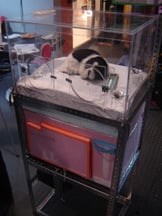

Lungs simply aren't designed to breathe until the baby is close to full term, which is currently defined as 39 weeks, and even the gentlest techniques to assist breathing can damage the tissue. Of the survivors, many are left with long-term health problems. Although modern medicine can save many of them, the chances of survival for extremely small preemies-those younger than 28 weeks, barely in their third trimester-remain slim. Mott Children's Hospital, in Ann Arbor, he often sees premature babies who have left the womb too soon. As a fetal and pediatric surgeon at the University of Michigan's C.S. But George Mychaliska thinks that creating an artificial version of the placenta, or at least replicating its most important function, is in reach. There's still too much that scientists don't know about the early stages of development, when fetal cells grow into organs, limbs, and tissues. Re-creating everything that happens inside the womb belongs firmly in the realm of science fiction. Her oxygen flows seamlessly into the fetus's beating heart, brain, and limbs, and carbon dioxide from the fetus returns to the mother's blood, to be exhaled in her breath. Over a convoluted surface that grows large enough to cover a horse, fetal blood on one side soaks up oxygen from mom's blood on the other.

The placenta starts to “breathe" for the fetus around 12 weeks in. Even before a woman knows she's pregnant, the placenta swells in size, poised to serve as the fetus's kidneys and liver until the fetus has its own. But that magnificent conversion would be impossible without the placenta, the life-giving organ that the developing fetus is tied to via the umbilical cord. The womb is home to the most complex feat of human biology: the transformation from embryo to fetus to baby.


 0 kommentar(er)
0 kommentar(er)
